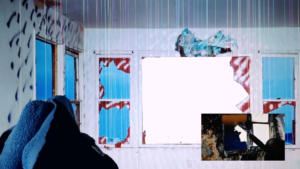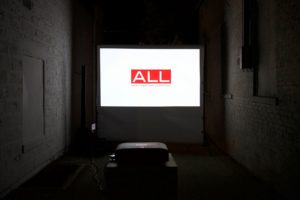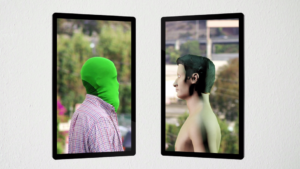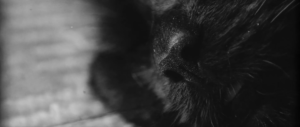 Review: Limited Run
Review: Limited Run
OFF the WALL: Nights 1 & 2 | Various Artists | 2014-2016
Arts + Literature Laboratory, 2021 Winnebago Street, Saturday, August 13, 9:00pm»
A much needed microcinema-style series for local and international video art has debuted at the Arts + Literature Laboratory. James Kreul explains why this matters, and surveys some of the titles curated by programmers Simone Doing and Max Puchalsky, a.k.a. Simone and Max.
As noted by our friends at LakeFrontRow, if you threw a rock in Madison this summer, it probably landed in the middle of an outdoor movie screening.* Programming at several outdoor series leans towards easily digestible popular films that many attendees have already seen. The images and sounds function like background music at a social gathering, with an emphasis on the brew over the view, the catch over the reel, the food cart over the cinema.
This is not the only way to think about a community-based outdoor screen experience.
Simone Doing and Max Puchalsky, a.k.a. Simone and Max, co-founders of the Midwest Story Lab, have taken a distinctly different approach for their outdoor series, OFF the WALL, which debuted last week at the Arts + Literature Laboratory and concludes with a second screening on Saturday, August 13. In their own work, the duo define their overall approach to screen culture as investigating the “potential of the public screen as a mobilizing force to build empathy, action, and long-term responsibility.” With the OFF the WALL screenings Simone and Max bring bring the public to the public screen for a survey of local and international video art.
OFF the WALL marks the first attempt at a new series in Madison devoted to contemporary experimental moving images in quite a while. And as campus venues, including the Wisconsin Film Festival and WUD Film’s Starlight Cinema, slowly drift away from experimental film**, OFF the WALL’s goal of bringing video art to general audiences seems even more significant.

I’m woefully late in posting this; personal obstacles prevented me from previewing Night 1, and I hope people reading this will have a chance to catch the second screening on Saturday (I’ll be there for sure). Across the two evenings, selections range from 30 seconds to 13 minutes in duration, which should help acclimate those new to the form. But there’s also plenty here for those who know they are tired of summer blockbuster fare, and crave alternative ways to think about image making.
If I can be forgiven for wildly over-simplifying contemporary experimental media, one can divide contemporary modes of production and practice into two broad categories: the black box and the white cube. By the black box, I mean the darkened cinema auditorium, the mode of experimental film that in Madison has been showcased at Starlight Cinema, UW Cinematheque, and the Wisconsin Film Festival. By the white cube, I mean the contemporary art gallery, in which the projected image has functioned slightly differently. Broadly speaking, most of the OFF the WALL work comes from the white cube strain in terms of institutional support (distribution and exhibition). The black box and white cube are not mutually exclusive modes; Michael Snow and Paul Sharits come to mind as examples of artists who have exhibited in both contexts as the institutional split began to emerge.
 Looking back at Night 1: One significant difference for the projected image in the white cube of the gallery is the option for multi-channel video installations. Although Simone and Max specified single-channel work in their call-for-entries last month, several of Night 1’s projects seem to have their origins in multi-screen projections and loops.
Looking back at Night 1: One significant difference for the projected image in the white cube of the gallery is the option for multi-channel video installations. Although Simone and Max specified single-channel work in their call-for-entries last month, several of Night 1’s projects seem to have their origins in multi-screen projections and loops.
One multi-screen project that translates well to single-channel is Simón García-Miñaúr’s An Unexpected Visit (2015). In one screen, a man wrapped head to toe in special effects green screen material goes through his day as his voice over laments over a failed relationship. In the other screen, the lover eventually appears as a CGI figure, in a manner that now calls to mind the augmented reality of Pokemon Go. The screens themselves suggest the portrait mode of a smartphone. García-Miñaúr finds the right balance of humor, deconstructed melodrama, and media reflexivity to comment on the current state of our mediated lives and relationships.
Other strong multiple screen pieces included Emilia Izquierdo’s Blind Light/White Noise, which mixed different textures (digital noise, watercolor-like animation) to great effect; Ima -Abasi Okon’s #########################, which provocatively juxtaposed images from a training video for detecting improvised explosive devices with the music video for D’Angelo’s “Untitled (How Does It Feel?),” and Wu Siou Ming’s The English Word “Asia,” which distracts your attention away from the soundtrack just long enough before you realize how completely you’ve absorbed some not-s0-flattering media conventions and codes (hint: despite the subtitles, actually listen to the voice over).
Other broad trends in the white cube tradition of video art could be seen in Night 1. Text heavy examples ranged from the poetically theoretical voice over (Lina Selander’s The Offspring Resembles the Parent) to multiple-font multitasking (Laura Hyunjhee Kim’s A Story of Now). The abundance of text and spoken word (especially text-to-speech generated voice over) made sense for the night’s themes of language and communication. Performance centered pieces included Eden Auerbauch Ofrat’s Scapegoat and Steve Roggenbuck’s I Am Not Responsible for Anything the Moon Does This Month. Broadly speaking, the documentation of the performance in this strain is often more important than visual aesthetics.
 One of my favorites of the first evening, Alejandro Sajgalik’s zuma_cuts.mov (see image above), successfully explores the material properties of contemporary digital imagery by taking cut and paste literally—with an X-Acto knife. Perhaps I appreciated it more in this context because the focus was exclusively on the imagery, sans text. The less successful examples from the first evening tended to lean a bit too heavily on their theoretical underpinnings and were underdeveloped as self-contained pieces: Mikio Saito’s Koala at a Rebellious Age, Laura Hyunghee Kim’s Privacy Stock Footage, and Pinar & Viola’s Mother Earth in Paris.
One of my favorites of the first evening, Alejandro Sajgalik’s zuma_cuts.mov (see image above), successfully explores the material properties of contemporary digital imagery by taking cut and paste literally—with an X-Acto knife. Perhaps I appreciated it more in this context because the focus was exclusively on the imagery, sans text. The less successful examples from the first evening tended to lean a bit too heavily on their theoretical underpinnings and were underdeveloped as self-contained pieces: Mikio Saito’s Koala at a Rebellious Age, Laura Hyunghee Kim’s Privacy Stock Footage, and Pinar & Viola’s Mother Earth in Paris.
A final thought before moving on to Night 2: One piece the first night did not seem to fit, but in a good way. K by Gianrico Di Gennaro (a.k.a. El Zoid) was one of the few first night pieces that allowed the images to breath a little bit more, without forcing them to serve a more exact theoretical or conceptual purpose. So much so, in fact, that at first you’re not exactly sure what you’re looking at, to an unsettling effect. Sure, we know it’s a cat, but a cat in what state exactly? More so than other pieces the first evening, K seemed more aligned with the experimental film tradition (specifically recalling Maya Deren’s Private Life of a Cat and Joyce Wieland’s Cat Food).
 Looking ahead to Night 2: I’ve only had time to preview a few of the second night’s offerings, but the ones that I’ve looked at have tended to allow the images to breathe a bit more, in the manner of Di Gennaro’s K. I’m looking forward to catching these with the crowd tonight (and while links to some are available, I’ll add them after the show to encourage you to attend the screening).
Looking ahead to Night 2: I’ve only had time to preview a few of the second night’s offerings, but the ones that I’ve looked at have tended to allow the images to breathe a bit more, in the manner of Di Gennaro’s K. I’m looking forward to catching these with the crowd tonight (and while links to some are available, I’ll add them after the show to encourage you to attend the screening).
Yao Cong’s Under Blue broadly speaking fits into the performance and body art trend in video art, but it will remind you more of Di Gennaro’s K in its exclusive use of close ups and the effect of not really understanding what we’re looking at. Yes, we understand broadly that makeup is being applied to a human face, but we’re uncertain of the exact context, leaving us to appreciate the colors and the textures of the skin and make-up materials. When a new material is introduced, our attention to those colors and textures is greatly rewarded, even as we understand the context even less.
Mikey Peterson’s Slip Away could easily be ruined by over-description, so I’ll keep my comments somewhat vague. When we first see the image, it is either something technically very complicated or overwhelmingly simple. As the image is allowed to evolve slowly, we soon discover that it is the latter, and like Under Blue that sense of discovery is one of the work’s great rewards.
Diego Bernaschina’s Código de señas would have fit very well in the first night’s theme of language and communication, and it probably would have been one of my favorites in that context as well. As with Under Blue and Slip Away, it works best precisely because one doesn’t know sign language, and it allows you to not understand. Instead, you’re overwhelmed and impressed by the mastery of visual rhythm in the opening, and the layered imagery and text that work both well both graphically and conceptually. Eventually, of course, the pieces come together and the signed letters are translated—if you know Spanish.
I’ll end with a brief comparison of two pieces that attempt to take political/rhetorical positions: Alysse Stephanian’s #MemoryoftheUniverse | “Syria Planum: For Water for Oil” and Andrew Ellis Johnson’s Massacre of the Innocents.
 Stephanian’s piece suffers from many of the sins at the extremes of political video art; while I was sympathetic to its political position, I found myself disagreeing with its aesthetics and rhetorical tactics. All of the visual metaphors are forced and obvious. There’s little to no subtlety, and the title suggests the semi-colons and subtitles in the echo-chamber of academic discourse. There’s also some pretty loose and I might argue irresponsible use of pretty heavy documentary imagery and audio. You don’t just plop in an image of a dead child, face down on a beach, with no context in the middle of your computer animated project, even if you are being critical of the conditions that led to that child’s death.
Stephanian’s piece suffers from many of the sins at the extremes of political video art; while I was sympathetic to its political position, I found myself disagreeing with its aesthetics and rhetorical tactics. All of the visual metaphors are forced and obvious. There’s little to no subtlety, and the title suggests the semi-colons and subtitles in the echo-chamber of academic discourse. There’s also some pretty loose and I might argue irresponsible use of pretty heavy documentary imagery and audio. You don’t just plop in an image of a dead child, face down on a beach, with no context in the middle of your computer animated project, even if you are being critical of the conditions that led to that child’s death.
Johnson’s piece, on the other hand, again allows the images to breath at least a little bit, and doesn’t overwhelm the viewer with the rhetoric from the first frame. Despite the title (which does not appear on screen) it is not immediately apparent what the video is about, and the viewer is allowed to discover the rhetorical stance through associations of images and sounds. Graphically the piece is far more interesting, as it develops themes and variations based on shapes and movement (the circles of a marksman’s target provide the starting point). It’s technically less ambitious, but overall far more intriguing and rhetorically effective. It doesn’t overwhelm you, it engages you.
I end with this comparison not to focus on the negative about Stephanian’s piece or to question its inclusion, but to suggest that we can’t have this kind of discussion, with comparisons and contrasts, unless we see more of this kind of work in town. For now, Simone and Max plan to return with more OFF the WALL in the Summer of 2017. Hopefully others will join them and step up to the plate to bring more experimental media to town in the interim.
*Of course this is an exaggeration. It would actually land in the middle of a music festival.
**Since writing this, the UW-Cinematheque has released its Fall calendar, which includes an evening of films by Paolo Gioli, and Lewis Klahr’s feature, Sixty Six.